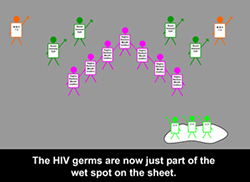Script for Sex in the City, An Inside View Video
See the User's Guide [DOCX - 160 KB] for more information about these presentations and how they may be customized.

Facilitator: Welcome to the educational theatre exercise: "Sex in the City; An Inside View." You will be a participant in this exercise and you will experience what really happens during sex; how HIV is transmitted and how STDs make it easier. My name is ________ and I will be your narrator. I’ll be walking you through each scene. I have the only speaking part. The PINK PARTS are non-moving, but the rest are moving parts. From time to time during the movements, I will issue a FREEZE command. At that time, all players should stop instantly.
Before we begin, let me introduce you to the players. First, we have a BODY CAVITY formed by the pink parts into the shape of a U. A body cavity is lined with PINK PARTS, which are really – squamous and columnar epithelial cells. This could be a vagina, rectum, urethra, or mouth. It doesn’t matter because the lining is the same in all sites. These cells overlap and form a barrier. All PINK PARTS now join hands. Choose the body cavity you would like to portray.
Next, meet the SUBMUCOSA. This is the layer just underneath the lining of the body cavity. Here you will find some WHITE BLOOD CELLS (WBC) who are soldiers in the ‘battle’ that takes place when germs enter any body cavity.
#1 is the Scout Immune Cell affectionately known as the SCOUT CELL. Scout immune cells include macrophage cells and dendritic cells. The Scout cell’s job is to rush to the pink parts if any germs or irritants get into the body cavity. The Scout cell then tries to destroy the germ.
#2 are the T4 LYMPHOCYTE CELLS. The T4’s job is to signal the bloodstream when the germ gets into the body cavity to get it to start making antibodies to fight off the infection.
A strange coincidence is that both Scout cells and T4s have a specific receptor on the outside called a CD4 RECEPTOR. These players please raise one arm and open your hand. Keep your arm raised.
Now, meet the HIV GERM. HIV is a scary germ, but really it's sort of wimpy in that it can’t live on its own. It has to get inside a cell and live there. If HIV doesn’t infect a cell and get inside it after 24 hours (often only 6 – 8 hours), it will die. The HIV germ has a protein on the outside called an ATTACHMENT PROTEIN. These players raise one arm and make a fist. In order for HIV to infect a cell, the attachment protein has to find a cell with a specific receptor. It just so happens that the one and only receptor that fits HIV, is the CD4 receptor (see the raised open hands). These of course, are on the Scout cells and the T4 cells. If this connection is not made, then infection can’t happen.
Lastly, meet the STD GERMS. These can be bacterial ones like gonorrhea and chlamydia, or viral ones like herpes. They all have the same effect in connection with HIV. Unlike HIV,
STD GERMS directly infect PINK PARTS. These players should do a doggie paddle motion with your hands and paddle against the joined hands of the PINK PARTS. PINK PARTS drop your arms to indicate that you have been infected and the layer of protection is disrupted.
Now, let the action begin.

SCENE 1:
Here is a healthy body cavity. See how the cells are joined and form a barrier (hands held). The Scout cells and T4 cells are under the surface, but not on the lining of the pink parts. Sex happens. It could be oral sex, vaginal sex or rectal sex, it doesn’t matter. The body fluid (either semen or cervical/vaginal secretions) gets into the body cavity. The body fluid has HIV germs in it. HIV germs please go into the BODY CAVITY with your arms raised with fists. The HIV germs are desperately looking for a CD4 receptor – in order to live. But, they can’t find one. The pink parts don’t have CD4 receptors and HIV can’t infect them. They also can’t reach the Scout cells or the T4 cells because the lining is intact. Scout cells please wave your raised arms with open hands. The HIV germs are dying...dying...dying...dead. HIV germs please run out of the body cavity. The HIV germs are now just part of the wet spot on the sheet. CUT!
Any questions, any answers? Process responses.

SCENE 2:
Here is the same healthy body cavity. See how the cells are joined and form a barrier (hands held). The Scout cells and T4 cells are under the surface, but not on the lining of the pink parts. Sex happens. This time, STD germs are in the semen or cervical/vaginal secretions. Unlike HIV, STD germs do attack the pink parts and infect those cells. STD germs please go into the BODY CAVITY and start paddling the joined hands of the pink parts. Pink parts should drop their hands after being struck. This wakes up the Scout cells that rush into the cavity to fight off the STD germs. Now, let’s say the person who owns this body cavity actually goes for care and gets treatment for the STD infection. The STD germs die. STD germs please run out of the body cavity. The Scout cells still hang out in the body cavity, because they’re not really sure what is happening. Maybe, the STD germs are coming back? CUT!
Explain that STDs aren’t the only things that cause Scout cells to come out into the body cavity. Things that cause inflammation, like douches, products, ectopy, etc. can have the same effect.
Any questions, any answers? Process responses.
SCENE 3:
Sex happens again. This time there are HIV germs in the semen/cervical vaginal secretions. HIV germs please enter the body cavity with your raised fists. This time, the HIV germs find their lifeline, the CD4 receptors on the Scout cells. Scout cells - please grab the fist of the HIV germ with your raised open hand. The Scout cells are now infected. They go back to the submucosa and they take the HIV germs with them. Attached Scout cells and HIV germs please move to the submucosa. There, they find the T4 cells and give some HIV to them. HIV germs give the T4 cells your small yellow card with HIV written on them. The T4 cells run to the bloodstream to alert other immune cells to begin making antibodies – but HIV finds more CD4 cells to attach to in the bloodstream and this is how the bloodstream becomes infected. T4 cells take the HIV card and run to the bloodstream. Meanwhile, infected Scout cells remain in the submucosa. CUT!
Any questions, any answers? Process any responses.

SCENE 4:
Now, this is the body cavity of a person who is living with HIV/AIDS. The HIV is in the bloodstream in the T4 cells and also still in the Scout cells under the surface of the pink parts. The pink parts are healthy, with just a little HIV being shed. Pink parts please join hands again and one HIV germ should stay in the cavity. The rest of the HIV germs please stay joined to the Scout cells in the submucosa. Sex happens AGAIN. This time, a STD is in the semen or cervical/vaginal fluids. STD germs please run into the body cavity. The STD germs again attack the pink parts and destroy some of the lining. Pink parts; please drop your joined hands. The Scout cells again come out to fight off the STD infection, but they bring the HIV germs with them. So, more HIV is being shed out making it more likely to be passed to other sex partners – more communicable. Now, let’s say that this person living with HIV/AIDS actually got STD testing and treatment. The STD germs will die. STD germs please run out of the body cavity. The Scout cells eventually go back to the submucosa and the amount of HIV germs in the body cavity goes down again. Scout cells please take the HIV germs and go back to the submucosa. One HIV germ should stay in the body cavity. So, by getting STD treatment, the person living with HIV/AIDS can reduce their chances of passing HIV to a sexual partner. CUT!
Any questions, any answers? Process responses.
FINAL SCENE:
Ask participants to come out of role now and to explain how the STD/HIV inter-relationships are like a double-edged sword. Ask participants what this information means for them. Ask how they could apply what they learned to their work with their clients.
- Page last reviewed: February 20, 2015
- Page last updated: February 20, 2015
- Content source:


 ShareCompartir
ShareCompartir